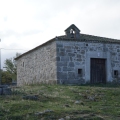The devotion to Madonna della Libera began in Benevento in 663, when she supposedly freed the city from the siege of Emperor Constans II, appearing with a cross on her palm, a distinctive symbol in her iconography. Her most venerated image is a Byzantine icon, taken to Rodi Garganico in the 15th century. The devotion spread to several Italian regions, including Cercemaggiore, Maiori, Moiano, Aquino, and Filetto. Padre Pio of Pietrelcina was a devoted follower, calling her “La Madunnella nostra”, strengthening her veneration in Pietrelcina, where she is celebrated on the first Sunday of August.
The Church of Madonna della Libera, located outside Filetto, near the road to Guardiagrele, features a neo-Renaissance style with an elegant brick façade, adorned with paired pilasters and a triangular pediment. It has a three-nave structure with a semicircular apse, covered by a lunette barrel vault in the central nave and sail vaults in the lateral ones. Originally a small chapel from the 14th century, it was dedicated in 1799 to Madonna della Libera, credited with repelling French troops from the area. In 1860, the hermit Vincenzo Libertini promoted the construction of the current sanctuary, gathering donations from nearby villages.
Despite wartime damage, it was restored and reopened in 1950, becoming the third most important sanctuary in the Diocese of Chieti, after Casalbordino and Monteodorisio. Its neoclassical interior features golden stucco decorations, a large dome fresco, and the ancient sacred image of the Madonna, venerated in a candle-lit niche. The rich late Baroque Lombard-style decorations resemble those in Guardiagrele’s churches.
- Address
Via Madonna della Libera, Filetto, Italy - Web
None - Visiting Hours
Unknown - What to see
Ancient image of Madonna della Libera




